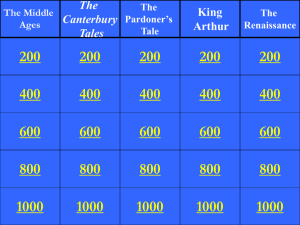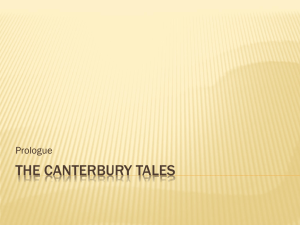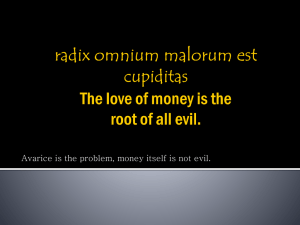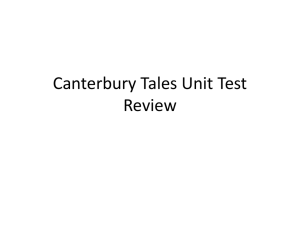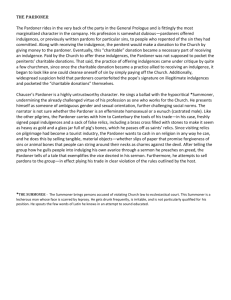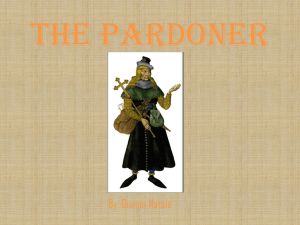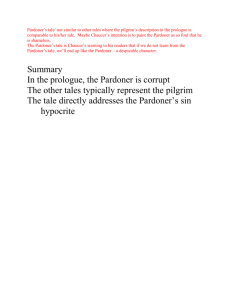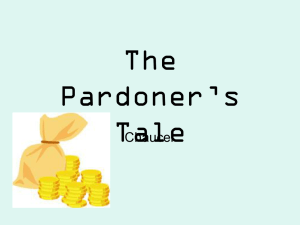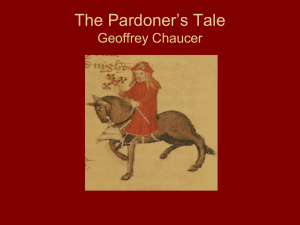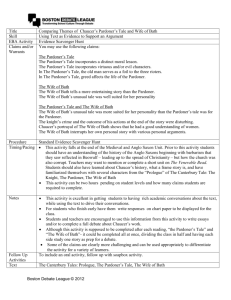Notes on The Pardoner`s Tale
advertisement
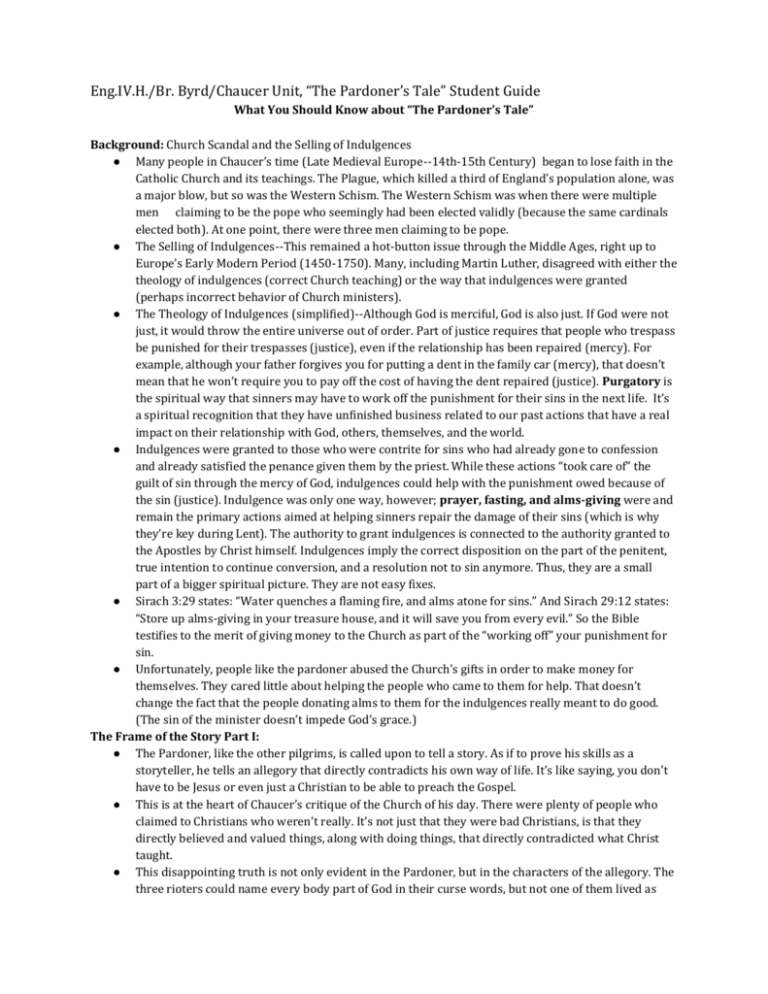
Eng.IV.H./Br. Byrd/Chaucer Unit, “The Pardoner’s Tale” Student Guide What You Should Know about “The Pardoner’s Tale” Background: Church Scandal and the Selling of Indulgences ● Many people in Chaucer’s time (Late Medieval Europe--14th-15th Century) began to lose faith in the Catholic Church and its teachings. The Plague, which killed a third of England’s population alone, was a major blow, but so was the Western Schism. The Western Schism was when there were multiple men claiming to be the pope who seemingly had been elected validly (because the same cardinals elected both). At one point, there were three men claiming to be pope. ● The Selling of Indulgences--This remained a hot-button issue through the Middle Ages, right up to Europe’s Early Modern Period (1450-1750). Many, including Martin Luther, disagreed with either the theology of indulgences (correct Church teaching) or the way that indulgences were granted (perhaps incorrect behavior of Church ministers). ● The Theology of Indulgences (simplified)--Although God is merciful, God is also just. If God were not just, it would throw the entire universe out of order. Part of justice requires that people who trespass be punished for their trespasses (justice), even if the relationship has been repaired (mercy). For example, although your father forgives you for putting a dent in the family car (mercy), that doesn’t mean that he won’t require you to pay off the cost of having the dent repaired (justice). Purgatory is the spiritual way that sinners may have to work off the punishment for their sins in the next life. It’s a spiritual recognition that they have unfinished business related to our past actions that have a real impact on their relationship with God, others, themselves, and the world. ● Indulgences were granted to those who were contrite for sins who had already gone to confession and already satisfied the penance given them by the priest. While these actions “took care of” the guilt of sin through the mercy of God, indulgences could help with the punishment owed because of the sin (justice). Indulgence was only one way, however; prayer, fasting, and alms-giving were and remain the primary actions aimed at helping sinners repair the damage of their sins (which is why they’re key during Lent). The authority to grant indulgences is connected to the authority granted to the Apostles by Christ himself. Indulgences imply the correct disposition on the part of the penitent, true intention to continue conversion, and a resolution not to sin anymore. Thus, they are a small part of a bigger spiritual picture. They are not easy fixes. ● Sirach 3:29 states: “Water quenches a flaming fire, and alms atone for sins.” And Sirach 29:12 states: “Store up alms-giving in your treasure house, and it will save you from every evil.” So the Bible testifies to the merit of giving money to the Church as part of the “working off” your punishment for sin. ● Unfortunately, people like the pardoner abused the Church’s gifts in order to make money for themselves. They cared little about helping the people who came to them for help. That doesn’t change the fact that the people donating alms to them for the indulgences really meant to do good. (The sin of the minister doesn’t impede God’s grace.) The Frame of the Story Part I: ● The Pardoner, like the other pilgrims, is called upon to tell a story. As if to prove his skills as a storyteller, he tells an allegory that directly contradicts his own way of life. It’s like saying, you don’t have to be Jesus or even just a Christian to be able to preach the Gospel. ● This is at the heart of Chaucer’s critique of the Church of his day. There were plenty of people who claimed to Christians who weren’t really. It’s not just that they were bad Christians, is that they directly believed and valued things, along with doing things, that directly contradicted what Christ taught. ● This disappointing truth is not only evident in the Pardoner, but in the characters of the allegory. The three rioters could name every body part of God in their curse words, but not one of them lived as Eng.IV.H./Br. Byrd/Chaucer Unit, “The Pardoner’s Tale” Student Guide though he believed such a God really existed or that it didn’t matter (Psalm 10:11 and Psalm 94:7). Isn’t this true of Christians today? Christians who are culturally Christian, but not personally so? The Allegory: ● An allegory is simply a story in which the author blatantly weaves two levels of meaning into the plot through archetypical characters and other symbols. Allegory also usually have patterns of three (to help with memory and prediction), clear moral, and an ending in which the bad are punished and the good are rewarded) ● Because this story’s theme is the evils of greed, the gold represents the moral test that the main characters ultimately fail. They are punished by death. ● The story is a commentary on greed, but also on the topic of Death, a character represented by the very old man you cannot die. One may fight Death, but Death seems to effortlessly win-out in the end. (See Psalm 40 and Luke 12-13-21). Granted, due to the Black Death/The Plague, it’s understandable that anyone would like to “kill death”. But, as John Donne, Anglican poet, priest, and saint articulates in Holy Sonnet 72, death has died, but only through the actions of Christ which make of death a passageway to eternal life. In any case, Death can be read to be a friend to humanity, as much as he his this source of ultimate punishment for wickedness. See also Emily Dickinson’s poem “Tie the Strings of My Life” for an example of something totally ready for death. ● Moral of the story: There’s no honor among thieves. Money is the root of all evil (1 Timothy 6:10). Frame Story Part II: ● The insulting thing about the Pardoner is the way in which he takes his listeners to be fools. After telling an allegory against greed, he proceeds to try and get money out of his fellow pilgrims, who by now know he’s unrepentant ● We the readers have to respond not simply to the allegory, but to the frame story. Chaucer wants to provoke action on our part. What do we do in the face of such hypocrisy? ● Jesus’ response to corrupt spiritual leaders is extremely direct and harsh. See his tirade against the Sadducees and Pharisees in Matthew 23. ● Ironically, the greatest lesson learned from the Pardoner is taken from his own personality. He’s a perfect example of What Not to Do. ● Relevancy: Catholics often under-appreciate the causes and the subsequent benefits of the Protestant Reformation (1517). One of which was shedding light on some of the abuses in the church related to clerical greed and lust. Instead of blaming Protestants for divisions in the Church, Catholics need to recognize the internal issues that led to us divisions, beside acknowledging that a forced unity is no real unity to begin with. Other Literary Notes: ● There are several good examples of banter in “The Pardoner’s Tale”. Can you find a case? ● The role of Satan in the story is interesting. Like in the biblical book of Job or the stories of Jesus’ temptations, Satan plays the role of tempter to the three rioters. Unlike with Job, or Jesus, the rioters are tempted because: “To men in such a state the Devil sends/thoughts of this kind, and has a full permission/to lure them on to sorrow and perdition.” In this case, the sinners themselves are to blame, because their actions invite Satan’s influence. Just as with Job and Jesus, God the Father allows Satan to play this role. ● The gold is not just a symbol of death--fitting for this allegory--it also serves as an important literary device. It’s the reason the three rioters break their pact and end up doing the thing they were blaming Death for during at the story’s beginning (killing youth). The fact that there is so much of it is why the men cannot move it in daylight, which causes the one man to be sent off alone, which allows the other two to plot against him, etc. Money, in this case, moves this story completely. Eng.IV.H./Br. Byrd/Chaucer Unit, “The Pardoner’s Tale” Student Guide Other Relevancy Connections: ● Lord Voldemort of J.K. Rowling’s Harry Potter series is now one of the classic examples of someone out to cheat death through his own efforts. In The Deathly Hallows, there is a legend concerning three brothers who seek to cheat death.
